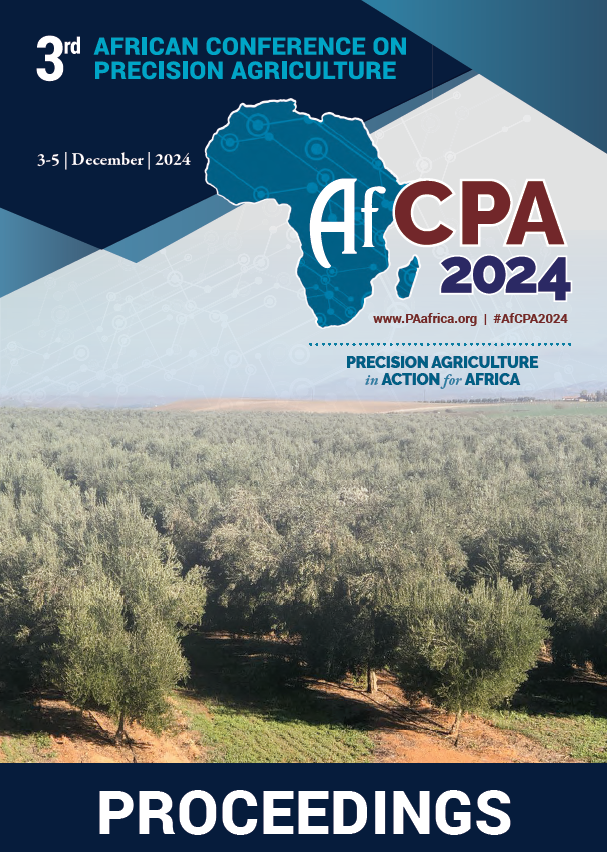Download the Conference Proceedings
Proceedings
Authors
| Filter results9 paper(s) found. |
|---|
1. Digital platforms for boosting farmer knowledge: Two case studies in Kenya and UgandaApproximately 80% of all farms in Africa, or 33 million farms, are two hectares or less in size. Many of these smallholder farmers do not have access to resources, including extension services, to improve their farms. Lack of knowledge of Good Agronomic Practices (GAPs) causes farmers to fail to reach their full yield potential. Extension workers responsible to provide these GAPs to farmers are spread thin. For example, as of March of 2019, there was one extension worker for every 1,800 coffee... E. Bakirdjian, T. Harigaya, M. Osia, J. Zhu, J. Abuli |
2. Delineation of site-specific management zones based on soil apparent electrical conductivity (ECa) measurement combining traditional soil sampling methodSite-specific management requires the identification of treatment areas based on homogeneous characteristics. The designation of subfield regions is challenging because of complex correlations appearing in spatial variability of soil properties and nutrient concentrations. The research was conducted on two neighbouring fields (48 ha and 15 ha) in Fejér county, Hungary. Soil ECa mapping was carried out on 22 October, 2019 and soil samples were taken on 15 November, 2019.... I.M. Kulmany, V. Vona, M. Vona, L. Szekeres, L. Bede, G. Milics, B. Kovacs |
3. Precision Farming Technology to Increase Soil and Crop Productivity in Egypt Using Remote Sensing and GISPrecision farming or site-specific land management is a new approach for development the agriculture processes to increase the soil and crop productivity with saving efforts and costs. Precision farming includes many techniques such as Global Position Systems (GPS), Geographic Information Systems (GIS), Remote Sensing (RS), Yield Monitors, Internet of Things (IOT), Variable Rate Application (VRA), Yield Mapping, Site-Specific Management Zones (SSMZ) and Crop Modeling. SSMZ delineation can be improved... A. Belal, M. Elsayed , M.E. Jalhoum, M. abdelatif , E. Hendawy , M. Emam, M. Zahran |
4. IMPACT OF SENSOR-BASED PRECISION NITROGEN MANAGEMENT ON WHEAT YIELD AND NITROGEN USE EFFICIENCYOptical sensors are promising new technology for precision nitrogen management in crops. Fertilizer N management for wheat (Cultivar: Giza 171) using optical sensor (GreenSeeker®) was evaluated at the Experimental Farm of Faculty of Agriculture, Cairo University, Giza Governorate, Egypt. The experiment was laid out in randomized block design with three replications during two successive winter seasons (2017/2018 and 2018/2019) to quantify the relationship between N uptake at jointing growth... A.A. Soaud, E.A. El-metwally , A.M. Ali, R.K. Sayed |
5. A reinforcement learning based approach for efficient irrigation water managementDue to population growth and the effects of climate change, most of the world's regions are threatened by water scarcity, especially in Africa and the Mediterranean region. In Morocco, agriculture consumes more than 85% of available water. Thus, to preserve water resources, the rational management of irrigation water is necessary. In this context, recent technological progress and the emergence of artificial intelligence could provide an effective decision support tool for the rational and... C. El hachimi, S. Belaqziz, S. Khabba, A. Chehbouni |
6. Fighting Food, Fertilizer, and the Climate Crisis in Africa Through Targeted Nitrogen ManagementFood insecurity is a major challenge in Africa which is likely to worsen in the future unless food production in the region is substantially increased to keep up with the food demand of the increasing population. A sufficient amount of nitrogen (N) fertilizer is required for increasing crop yield as N helps convert solar radiation into carbohydrates that drive plant growth. However, smallholder producers in Africa use a small quantity of fertilizer N not sufficient for plant needs resulting... T. Sapkota, N. Cheerakkollil konath, R. Takele, S. Snapp |
7. Leaf-proximal Hyperspectral Data and Multivariate Modelling Approaches to Estimate Phosphorus and Potassium Content of Wheat LeavesThe assessment of plant nutrient status to provide sufficient fertilization for rapid and continuous uptake by plants has been based on visual diagnosis in the field, which is quick but demands a lot of experience and has low operability. Visible near-infrared spectroscopy (VNIS) has shown to be a quick, non-destructive, accurate, and cost-effective analytical method in precision agriculture. In this study, we assessed the potential of this technology to predict phosphorus and potassium content... Y. El-mejjaouy, B. Dumont, P. Vermeulen, A. Oukarroum, B. Mercatoris |
8. Photogrammetrically Assessed Smallholder Pineapple Fields in Ghana Using Small Unmanned Aircraft SystemsUltra-high-resolution imagery taken by small unmanned aircraft systems (sUAS, drones) has been proven beneficial for the monitoring of agricultural crops in conventional farming especially in the context of precision farming. For smallholder pineapple cultivation, the use of sUAS imagery is still sparsely evaluated. However, technical developments in low cost sUAS-sensor combinations make assessments of agricultural areas by service providers more and more affordable for Africa. In this study,... M. Hobart, E. Anin-adjei, E. Hanyabui, G. Badu-marfo, M. Schirrmann, N. Schiller |
9. Influence of Mulched-drip Irrigation System on Yield and Physiological Attributes of Pepper Varieties in Southwest, Nigeria... I. Kehinde |
